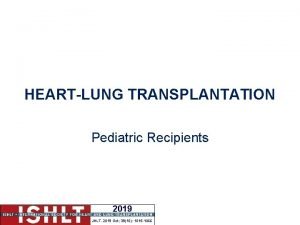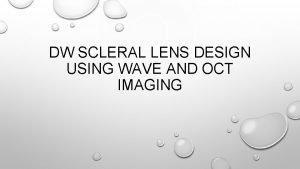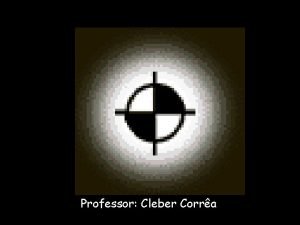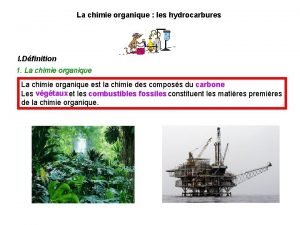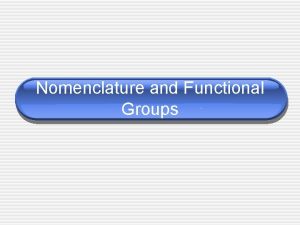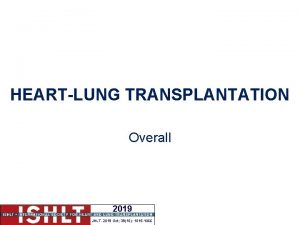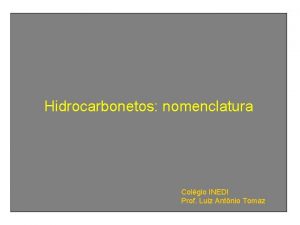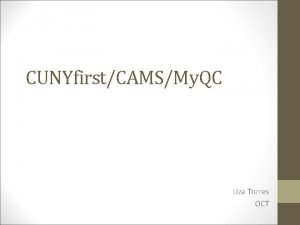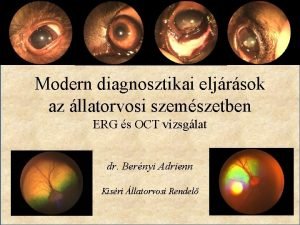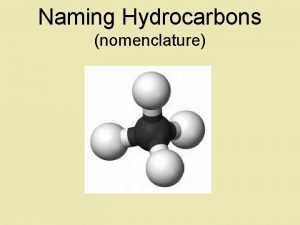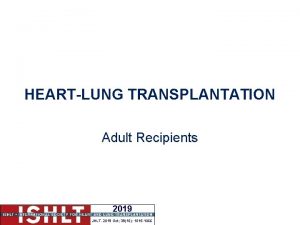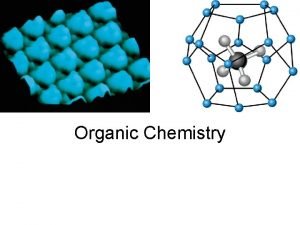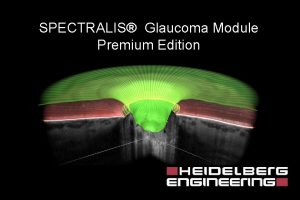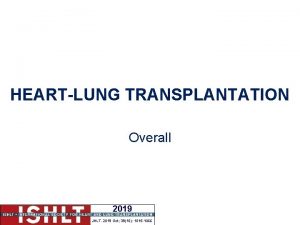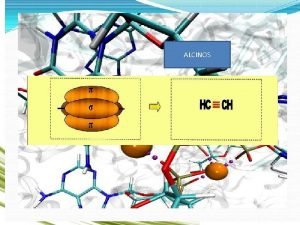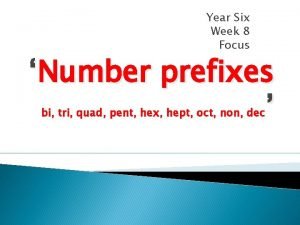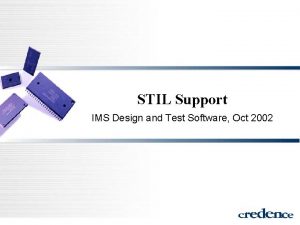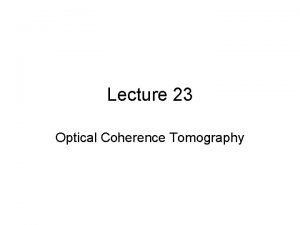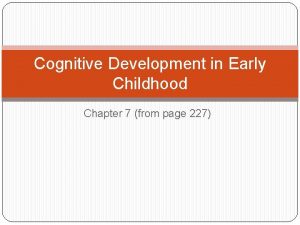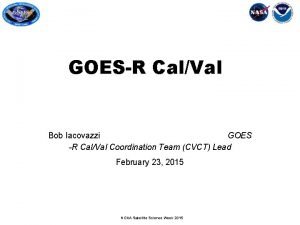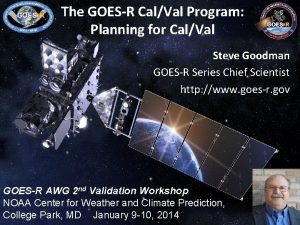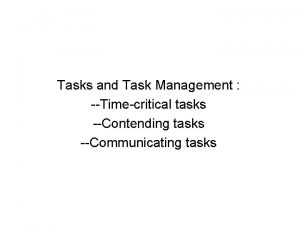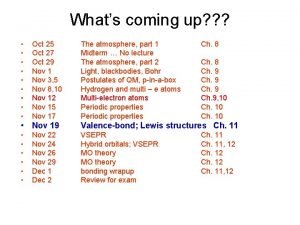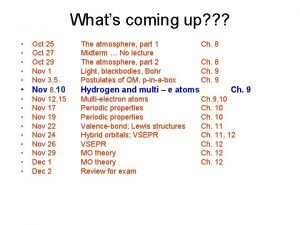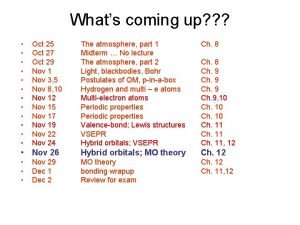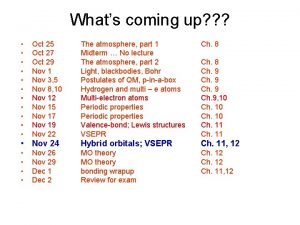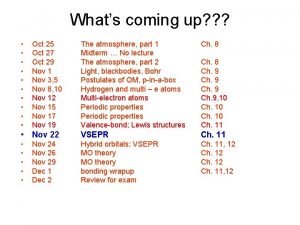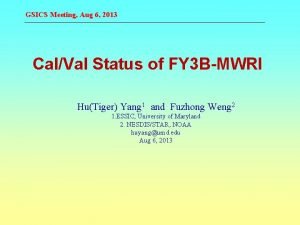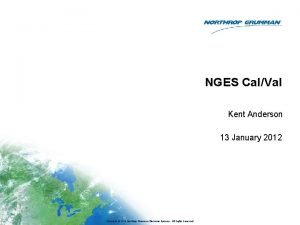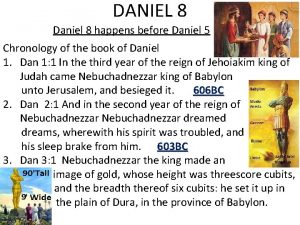MITLL CalVal tasks status Oct 23 2012 Daniel


































- Slides: 34

MIT/LL Cal/Val tasks status Oct 23 2012 Daniel L. Mooney SOUMI NPP SDR Product Review October 23, 2012 MIT Lincoln Laboratory 999999 -1 XYZ 9/25/2021

MIT/LL Cal/Val task completion 10/23/2012 • 999999 -2 XYZ 9/25/2021 Further analysis to complete MIT Lincoln Laboratory

MIT/LL Task 1 Interferometer Optimization 90% Task Objective: • Evaluate the performance of the interferometer on orbit Description: – Review raw earth, ICT less space spectra for systematic gain and phase variation with orbit. Responsivity stability over the orbit. Compare calibration residuals over multiple orbits. Comparisons to final TVAC testing, HK, and Dwell data Possible change to on orbit operation: – Scan baffle temperature profile Task work – Comparing biases for different calibration algorithms – Laser monitoring – Ripple sources Status - 90% complete – Looking at systematic bias and ripple 999999 -3 XYZ 9/25/2021 MIT Lincoln Laboratory

Different calibration approaches Current ATBD approach Current Order, v 2. 20 of SDR Algorithm: calibration SNLcorr • • Nonlinearity correction Resampling to User Grid Bandpass Filter Calibration is done in a shifted wavenumber space and then shifted back with F-1. Working with Exelis on revised calibration proposal below Direct approach Calibration in final wavenumber space Sraw • • • 999999 -4 XYZ 9/25/2021 FIR gain removal Nonlinearity correction Covert all extended spectra to final wavenumber scale Single F matrix performs all corrections ( FINT, ILS & resampling) Calibration done with final spec wavenumbers MIT Lincoln Laboratory

Small differences between SDR and RDR(LLcal) • • Segregated into corners, edges, and center Gain error with Hamming applied to reduce ringing center sides corners 999999 -5 XYZ 9/25/2021 MIT Lincoln Laboratory

LW (RDR-SDR) in-band vs. SDR in-band for granule NPP 000271296803 center sides corners RDR gain to remove tilts 999999 -6 XYZ 9/25/2021 MIT Lincoln Laboratory

Difference between LW IDPS and LL calibrated spectra with Hamming without Hamming with Hamming Large ringing difference Fixed gain applied to RDR(LLcal) results 999999 -7 XYZ 9/25/2021 MIT Lincoln Laboratory

SW (RDR-SDR) in-band vs. SDR in-band for granule NPP 000271296803 center sides corners RDR gain to remove tilts 999999 -8 XYZ 9/25/2021 MIT Lincoln Laboratory

Difference between SW IDPS and LL calibrated spectra without Hamming with Hamming Large ringing difference Fixed gain applied to LLcal results 999999 -9 XYZ 9/25/2021 MIT Lincoln Laboratory

MW (RDR-SDR) in-band vs. SDR in-band for granule NPP 000271296803 • Curvature on FOVs 3, 7 and, 8 is a nonlinear difference Fixed gain applied to LLcal results 999999 -10 XYZ 9/25/2021 MIT Lincoln Laboratory

Difference between LW IDPS and LL calibrated spectra with Hamming without Hamming with Hamming Large ringing difference Fixed gain applied to LLcal results 999999 -11 XYZ 9/25/2021 MIT Lincoln Laboratory

Comparisons of results • • • 999999 -12 XYZ 9/25/2021 Large ringing in differences almost completely removed with Hamming filter Small gain differences in the results Cain adjusted results differ by less than +/- 1 m. K in LW and SW band, and +/- 5 m. K for the MW band shows nonlinear difference for band 3, 7, and 8 All differences have large ripple which is most likely due to delta function approximation in CMO MIT Lincoln Laboratory

Delta function approx error summary • How good is the approximation? • The answer is not too good. The errors occur across the band are ripples • The mean errors over an ensemble of x and y • Actual transformation from extended FOV to on axis ray is a summation of many integrals with different R=Duspec/Dua 999999 -13 XYZ 9/25/2021 MIT Lincoln Laboratory

LW band delta function approximation error for R NOT 1 999999 -14 XYZ 9/25/2021 MIT Lincoln Laboratory

Small orbital dependent variation in metrology laser wavelength 999999 -15 XYZ 9/25/2021 MIT Lincoln Laboratory

MIT/LL Task 2 IR Channel Amplifier Gain 100% Task Objective: – Determine the overall gain in the interferogram Task Description: – Review all parameters needed for the overall gain in the interferogram including - temperature variation, amplifier gain, decimation filter, a 1, Vinst and laser diode temperature variation, ZPD peak over orbit Task work: – Tracked parameters over multiple orbits – Covered by other members Status – 100% complete 999999 -16 XYZ 9/25/2021 MIT Lincoln Laboratory

MIT/LL Task 3 NEDN performance and trending 100% Task Objective: Characterize the Cr. IS NEDN and trend over multiple orbits Task Description: – Estimate the NEDN for ICT and over multiple orbits – Evaluate noise sources for ICT and space looks – Process HDF 5 RDR data to independently access the noise Task work: – NEDN every hour Status - 100% complete – No significant change in instrument noise over 4 months 999999 -17 XYZ 9/25/2021 MIT Lincoln Laboratory

Find the maximum NEDN in the spectral range as a % of the specification NEDN estimated every hour Monitor maximum in: LW: 665 to 1095 cm-1 MW: full band SW full band 999999 -18 XYZ 9/25/2021 MIT Lincoln Laboratory

NEDN for September 1 - 4 2012 by the hour as % of upper limit 999999 -19 XYZ 9/25/2021 MIT Lincoln Laboratory

MIT/LL 4 Monitor Correlated Noise • Task Objective: – • 50% Assess correlation in real and imaginary noise Task Description: – Determine correlation matrix for spectral channels for different time scales – PCA analysis for single FOV – Cross correlation in the ICT noise for different FOVs • Task work: – Code modified for covariance estimation over 1 hour periods • Status – 50% – Spot tests over months show uncorrelated spectral noise 999999 -20 XYZ 9/25/2021 MIT Lincoln Laboratory

MIT/LL 5 Responsivity Stability 70% Task Objective: – Monitor complex responsively over multiple orbits Task Description: – Correlate with BATC environmental test results – Correlate with instrument temperature over orbits Task work: – Z=(Earth-SP)/(ICT-SP) and responsivity for small data sets – Responsivity for single orbits Status: 70% – Spikes in phase at terminator for calibrated spectra 999999 -21 XYZ 9/25/2021 MIT Lincoln Laboratory

LW variation in responsibility magnitude with orbit shows small periodic change in magnitude (%) • • change in phase (mrad) Effects due to temperature changes in thin films in Cr. IS No significant effect calibrated data with two point calibration 999999 -22 XYZ 9/25/2021 MIT Lincoln Laboratory

LW small residual phase variations in calibrated radiance produce most errors below 0. 03 % Radiance phase error at 900 cm-1 scale; err=1. e-4 = 6. 4 m. K 433 out of 2712965 above 6. 4 m. K (0. 03%) Tobin (UW) showed spikes coincident with terminator 999999 -23 XYZ 9/25/2021 MIT Lincoln Laboratory

MIT/LL 6 Spatial correlation and calibration averaging 100% Task Objective: – Estimate responsivity spatial correlation over multiple granules (~240 seconds) caused by calibration averaging Description: – Determine relative temporal noise contributions of ICT and SP and Earth for clear ocean scenes – Determine the correlation in responsivity for clear ocean scenes Task work: – None – staff shortage resolved will catch up quickly Status – 0% – Running calibrations with variable length cal averages 999999 -24 XYZ 9/25/2021 MIT Lincoln Laboratory

Correlated responsivity due to 30 point calibration average % change in responsivity Time power spectrum f=1/(240 sec) Correlation length 999999 -25 XYZ 9/25/2021 MIT Lincoln Laboratory

MIT/LL 7 Spatial integration of Cr. IS and ATMS 30% Task Objective: – Preliminary checks of the registration of Cr. IS and ATMS as prerequisite for Backus-Gilbert Task Description: – Use geographical edges and gradients to compare output from ATMS and Cr. IS, map model, ascending/descending orbit differences – Use double difference methods to correlate variation Task work: – Validated geolocation and timing Status: 30% – Optimal geolocation of Cr. IS and ATMS – Initial runs made using ADL 4. 0 for Crimss EDR 999999 -26 XYZ 9/25/2021 MIT Lincoln Laboratory

MIT/LL 8 ILS correction with structured earth scenes 20% Task Objective: – Evaluate the expected error in SDR data due to ILS correction for structured scene Task Description: – Use VIIRS images to evaluate the radiance distribution in the scene and the error relative to the uniform scene – Compare the variability in the estimated error with other errors – Autocorrelation of the spectrum Status: 20% 999999 -27 XYZ 9/25/2021 MIT Lincoln Laboratory

MIT/LL 9 Monitor long term repeatability 20% Task Objective: – Monitor long term repeatability for systematic bias and drifts using large ensemble averages. Task Description: – Clear ocean scenes with high confidence low structure atmospheric conditions suitable for large averages – Monitor radiometric differences between calibrated Earth scene radiances and data from AIRS, IASI, ECMWF, SNO for systematic differences Status: 20% – Examined results against LBL for clear ocean areas – Excessive averaging required to get noise down – Completed RDR calibration for golden days 999999 -28 XYZ 9/25/2021 MIT Lincoln Laboratory

Backup 999999 -29 XYZ 9/25/2021 MIT Lincoln Laboratory

Why does it work? • Starting with the direct calibration • The F operator has two functions – Removes distortion in structured spectra – Shifts spectra • 999999 -30 XYZ 9/25/2021 The ICT and Space spectra are fortunately unstructured and only shifted and the ratio is presumed to be the same under F which results in ATBD algorithm, MIT Lincoln Laboratory

Direct calibration • Exist well defined Matrices A and B that model the measurement process such that the: – On axis ray raw spectrum – Extended FOV raw spectrum • On axis ray calibrated spectra • Calibrated Cr. IS spectrum uses F matrix where -1 999999 -31 XYZ 9/25/2021 here implies pseudo inverse MIT Lincoln Laboratory

ATBD calibration • Presume that the measured spectrum can be written in terms of the on-axis ray spectrum as before • Rather than applying F-1 to get to the on-axis spectrum calibration is attempted with the raw extended FOV spectra • The presumption is that the ratio of measured spectra remains unchanged under F transformation 999999 -32 XYZ 9/25/2021 MIT Lincoln Laboratory

Ringing of impulse response to single wavenumber • The minimum ripple relative to the peak is (N+1)/2 bins from the peak db wavenumber • 999999 -33 XYZ 9/25/2021 Unavoidable ripple far from the peak as high a 0. 5% peak for SW band for a single channel MIT Lincoln Laboratory

LW band delta function approximation error for R=1 is essentially zero 999999 -34 XYZ 9/25/2021 MIT Lincoln Laboratory
 Cnes report
Cnes report Jhlt. 2019 oct; 38(10): 1015-1066
Jhlt. 2019 oct; 38(10): 1015-1066 Homologous series
Homologous series Visante oct
Visante oct Scleral lens oct
Scleral lens oct Met et prop but pent hex hept oct non dec
Met et prop but pent hex hept oct non dec 2 oct 1869
2 oct 1869 Meth eth prop but pent hex hept oct non dec
Meth eth prop but pent hex hept oct non dec Hex hept oct non dec
Hex hept oct non dec Meth eth prop but mnemonic
Meth eth prop but mnemonic Jhlt. 2019 oct; 38(10): 1015-1066
Jhlt. 2019 oct; 38(10): 1015-1066 Met et prop but pent hex hept oct non dec
Met et prop but pent hex hept oct non dec Whats emplid
Whats emplid Chemistry organic
Chemistry organic Działania na systemach liczbowych
Działania na systemach liczbowych Oct vizsgálat
Oct vizsgálat Organic chemistry vs biochemistry
Organic chemistry vs biochemistry Sunset on october 31st
Sunset on october 31st Eth meth prop but
Eth meth prop but Jhlt. 2019 oct; 38(10): 1015-1066
Jhlt. 2019 oct; 38(10): 1015-1066 Propiedades quimica del carbono
Propiedades quimica del carbono What is cooh in chemistry
What is cooh in chemistry Oct 3 1993
Oct 3 1993 Meth eth but prop
Meth eth but prop Met et prop but pent hex hept oct non dec
Met et prop but pent hex hept oct non dec Oct spectralis
Oct spectralis Jhlt. 2019 oct; 38(10): 1015-1066
Jhlt. 2019 oct; 38(10): 1015-1066 Metil acetileno
Metil acetileno Bi tri quad pent hex hept oct
Bi tri quad pent hex hept oct Stil oct
Stil oct Saturated and unsaturated hydrocarbons
Saturated and unsaturated hydrocarbons Principle of oct
Principle of oct The practical social side of language is called
The practical social side of language is called Elite desert tasks
Elite desert tasks Chastity tasks
Chastity tasks

